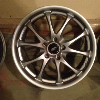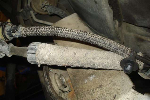Ferrari 360, Ferarri 550, Porsche 911 (Carerra/ 911/ GT2), Mercedes 500SL, Aston Martin Vanquish, Lamborghini Diablo, Lamborghini Murcielago.
All these high performance cars come from the factory with drilled and/or slotted rotors. There are more.
On tarmac, WRC rally cars use huge 15" rotors that are slotted.
If you take your Vette to John Lingenfelter or your Viper to John Hennesy, both of them slap on new rotors. Lingenfelter uses slotted and Hennesy uses drilled.
Here are some quotes from a few companies' web sites:
Mazdatrix: "Brake pads fade when the temperature of the material allows gases to "boil" out and create a layer separating the pad from the brake rotor. The holes in these rotors allow the layer to escape thereby keeping the pad in contact with the rotor. The rotor will also run cooler, which helps keep the pads cooler while also reducing the risk of fluid boiling. Note: Pads WILL still fade, and fluid WILL boil if the brakes are used beyond their SAFE capacity. Additionally, drilled rotors tend to crack around the holes due to heat expansion and contraction. Therefore there is no warranty on these parts, and the customer assumes all responsibility for their safe use."
Stillen: Drilled - "Computer-aided design, (CAD) is employed to determine the optimum pattern for any size Rotor. This pattern is critical, for it must correctly sweep the Brake Pad to increase its initial bite and allow for out-gassing while also cleaning the entire Brake Pad surface. The sweep will eliminate hot spots and maximize the Brake Pad friction to the rotor. The added air-surface, created by cross-drilling, will increase the rotors ability to dissipate heat and cool more effectively."
Slotted - "Both Slotted and Cross Drilled Rotors offer advantages over stock rotors. Cross drilled offer a better initial bite and braking, slotted are more resistant to high thermal loading. Like the cross drilled rotors above, CAD is used for optimizing the slot pattern."
Power Stop: "Question- Why should I use cross drilled rotors?
Answer- The primary reason is that they run cooler, approximately 200-250 degrees cooler when used with high quality pads. This reduces the chances of warping, which has become a major problem in recent years, particularly on late model U.S. made vehicles. Additionally you will experience improved wet weather braking. If you are experiencing pulsation on the brake pedal, your rotors are warped. It may be possible to turn them, but they will then be thinner and unable to dissipate heat as quickly, and will soon warp again."
Rod Millen Motorsports: "Computer-aided design, (CAD) is employed to determine the optimum pattern for any size rotor. This pattern is critical, for it must correctly sweep the Brake Pad to increase its initial bite and allow for out-gassing while also cleaning the entire Brake Pad surface. The sweep will eliminate hot spots and maximize the Brake Pad friction to the rotor. The added air-surface, created by cross-drilling, will increase the rotors ability to dissipate heat and cool more effectively."
Brembo:What are the advantages of drilled and slotted discs?
The main advantages of drilled and slotted discs are the same: increased brake "bite", and a continuous refreshing of the brake pad surface. Drilled discs have the additional advantage of being lighter and running cooler. However, there are certain pad materials that should not be used with a drilled disc."
There are more of those, but my post is way too long already. I do agree that cross drilled, and to a lesser degree slotted, rotors are more succeptible to cracking. However this doesn't happen very often. Even a drilled rotor has to be severely stressed to crack. Racing does this. But they also change rotors frequently, so even racers that use them don't have this happen too often. I have my own race experience, both sanctioned and, well, let's say "unsanctioned." Yes, I have seen cracked rotors, but it wasn't too common.










